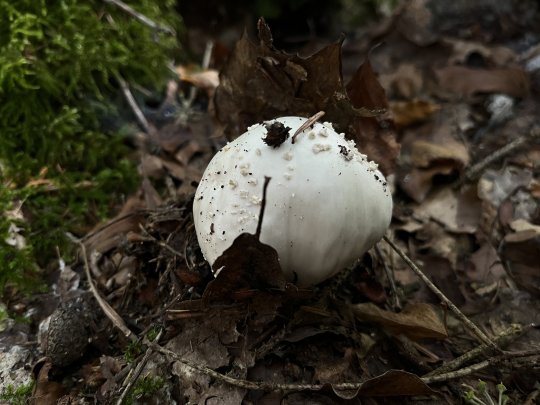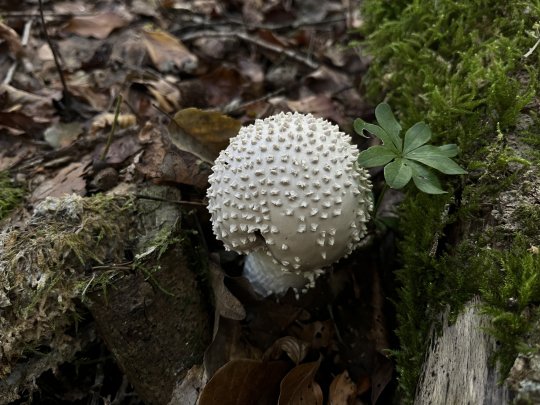Amanita echinocephala
Description
Amanita echinocephala is a distinctive mushroom species characterized by its large size, white or ivory-colored appearance, and spiny or warty cap. It thrives in chalky soils with beech trees, particularly in southern England, where it often emerges earlier than other large mushrooms. This species is typically found in solitary or small groups and is known as the "solitary amanita" or "European solitary lepidella." Notably, it exhibits impressive drought tolerance.
This mushroom is distributed across Britain, Europe, Western Asia, and North Africa, primarily appearing during the summer and early autumn months. It prefers well-drained, dry, calcareous soils, often in the vicinity of broad-leaved and coniferous trees. Its resilience to drought suggests that its northern range may extend to Southern England. In some regions, it coexists with Limes (Tilia) and occasionally with A. strobiliformis.
While some consider Amanita echinocephala edible, caution is advised due to the potential for confusion with toxic Amanita species. This rare and protected mushroom is listed on the United Kingdom Red Data List. There have been reports of it accumulating silver and possibly causing nephrotoxic effects similar to Amanita smithiana. In its early stages, the mushroom's appearance resembles that of Amanita muscaria, but as it matures, its cap does not exhibit a red background, and the spiny warts simply separate to reveal a white or cream-colored cap surface.
Common names: Solitary Amanita, German (Spitzkegeliger Wulstling).
Mushroom Identification
-
Cap
The cap can reach up to 15 cm (6 in) in diameter and is white to ivory or silver-gray. It has raised pyramidal warts, which become less prominent and frequent towards the edge. These warts are remnants of the universal veil that covers the mushroom in its early stages. Young buttons may be darker and sometimes resemble a two-tiered loaf with a ring of raised scales around the base.
-
Stem
The stem is white to ivory, 8–16 cm (3–6.5 in) tall, and 2–3 cm (1–1 in) wide. It has several rings of upturned scales near the bulbous base and is firmly anchored, often extending laterally below the surface. The ring is thin and fragile, often sticking to the stem.
-
Gills
The gills are cream-colored, occasionally with a slight greenish tint. They are mostly free from the stem and may have a small, decurrent tooth.
-
Flesh and Odor
The flesh is white and has an unpleasant odor.
-
Spores
The spores are ellipsoidal, smooth, measuring 9.5-11.5 x 6.5-8µm, and are amyloid.
-
Spore Print
The spore print is white.
-
Habitat
This mushroom is mycorrhizal and typically found in mixed woodlands with dryish calcareous soil. It may occasionally grow with conifers. It is known to occur in Britain, Europe, Western Asia, and North Africa, with a fruiting season from June to October.
Look-Alikes
-
Distinguished by a wart-like white cap with tattered veil fragments hanging from the brim. At maturity, its cap is still domed rather than flat.
-
Has conical warts on the cap, and have recurved scales right to the underside of the ring. It is usually found on heavier soils.
-
There is a white pouch residue on a white or light-colored grapefruit cap, but it is not pyramidal. Also, it has a brittle pendant ring.
History
It was first described as Agaricus echinocephalus in 1835 by the Italian mycologist Carlo Vittadini before being placed in Amanita by Lucien Quélet and consequently receiving its current binomial name. It derives its specific epithet, echinocephala, from the Greek "echino-" meaning "hedgehog" and "kephale," meaning "head."
Some authors have placed it in the Lepidella section of the Amanitaceae due to its lack of a well-formed volva.
Synonyms and Varieties
-
Agaricus aculeatus Vittadini (1835), Descrizione dei funghi mangerecci più comuni dell'Italia e de'velenosi che possono co'medesimi confondersi, p. 62
-
Agaricus albellus Scopoli (1772), Flora carniolica, Edn 2, 2, p. 417 (nom. rej.)
-
Agaricus echinocephalus Vittad., 1835 (basionym)
-
Agaricus nitidus (Fries) Fries (1838) [1836-38], Epicrisis systematis mycologici, p. 8
-
Agaricus solitarius Bulliard (1780), Herbier de la France, 1, tab. 48
-
Amanita aculeata (Quél.) Bigeard & Guillem., 1909
-
Amanita echinocephala var. bicollariata Boudier (1905) [1905-10], Icones mycologicae, tome 1, tab. 4
-
Amanita flandinia F. Plee (1864), Types de chaque famille et des principaux genres des plantes croissant spontanément en France ., 2, livret 57
-
Amanita nitida Fries (1815), Observationes mycologicae praecipue ad illustrandam floram suecicam, 1, p. 4
-
Amanita procera Persoon (1818), Traité sur les champignons comestibles, p. 186
-
Amanita solitaria (Bulliard) Fries (1836), Anteckningar öfver de i Sverige växande ätliga Svampar, p. 33
-
Amanita solitaria f. echinocephala (Vittadini) Costantin & L.M. Dufour (1891), Nouvelle flore des champignons … en France, Edn 1, p. 3
-
Amanita solitaria subf. bicollariata(Boudier) Neville & Poumarat (1996), Documents mycologiques, 26(101), p. 52
-
Amanita solitaria var. adamantina (Paulet) Quélet (1886), Enchiridion fungorum in Europa media et praesertim in Gallia vigentium, p. 3
-
Amanita strobiliformis subsp.* aculeata (Quélet) Saccardo (1887), Sylloge fungorum omnium hucusque cognitorum, 5, p. 15
-
Amanita strobiliformis var. aculeata Quélet (1886), Enchiridion fungorum in Europa media et praesertim in Gallia vigentium, p. 3
-
Amanita umbella f. bicollariata (Boudier) E.-J. Gilbert (1918), Le Genre Amanita, p. 101
-
Amanita umbella var. echinocephala(Vittadini) Quélet (1886), Enchiridion fungorum in Europa media et praesertim in Gallia vigentium, p. 4
-
Amanita vittadinii var. echinocephala (Vittad.) Veselý, 1934
-
Amanitina albella (E.-J. Gilbert) E.-J. Gilbert (1940), Iconographia mycologica, 27, supplément 1(1), p. 78
-
Armillaria echinocephala (Vittadini) Locquin (1952), Bulletin de la Société mycologique de France, 68, p. 167
-
Aspidella echinocephala (Vittad.) E.-J.Gilbert, 1941
-
Aspidella solitaria (Bull.) E.-J. Gilbert, 1940
-
Hypophyllum adamantinum Paulet (1808) [1793], Traité des champignons, 2, p. 358, tab. 162, fig. 2
-
Hypophyllum tricuspidatum Paulet (1808) [1793], Traité des champignons, 2, p. 359, tab. 163, fig. 3
-
Lepidella echinocephala (Vittadini) E.-J. Gilbert (1925), Bulletin de la Société mycologique de France, 41, p. 304
-
Lepidella echinocephala f. bicollariata (Boudier) Konrad & Maublanc (1926), Icones Selectae Fungorum, p. 38
-
Lepiota echinocephala (Vittadini) Gillet (1874), Les hyménomycètes, ou description de tous les champignons (fungi) qui croissent en France, p. 69
-
Venenarius solitarius (Bulliard) Murrill (1912), Mycologia, 4(5), p. 240
Video
Photo copyright:
All photos were taken by the Ultimate Mushroom team and can be used for your own purposes under the Attribution-ShareAlike 4.0 International license.









